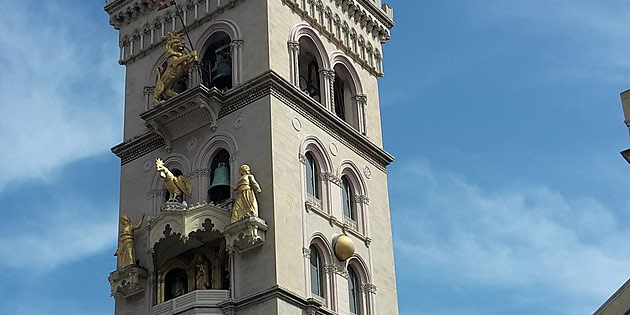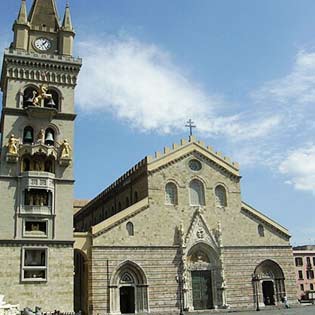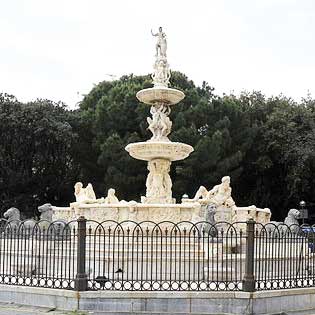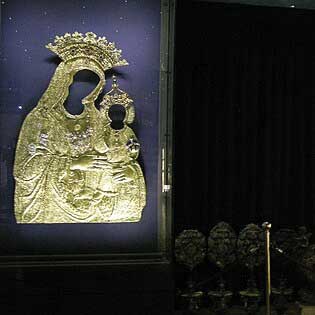Bell Tower Of Cathedral in Messina
The Campanile of the Cathedral of Messina, also known as Astronomical Clock of Messina, stands next to the Cathedral.
The current bell tower was rebuilt in its original location after the earthquake of 1908 and was designed on the drawings of the old one. About 60 meters high, it has the shape of a tower with a spire roof. It is lightened on all sides by pairs of mullioned windows with round arches and contains a magnificent animated clock commissioned by Archbishop Angelo Paino to the Ungerer firm of Strasbourg in 1933. This system is considered the largest and most complex. mechanical and astronomical clock of the world . It is defined as Time Clock , and it is a mechanical system capable of reproducing sounds and displaying a perpetual calendar and zodiac signs based on the reference period. Although part of its mechanical structure has now been modernized with more modern technologies, its original functions have almost remained unchanged.
The bell tower contains the largest concert in Sicily made up of 8 bells all cast by the Colbachini foundry of Padua in 1929. There are 2 other fixed bells, cast by Micheal Salicula in 1400. They were saved from the terrible Messina earthquake of 1908.
We recommend to visit the bell tower at noon when a complex system of counterweights, levers and gears allows the gilded bronze statues, placed on the facade facing the square, to move. The mechanism moves every day at 12.00 and lasts 12 minutes. Every quarter of an hour during the day the two heroines on either side of the rooster move, Dina and Clarenza, who strike the quarters and hours, and the carousel of the ages.
The bell tower can be visited inside. Along the path of the stairs, you can admire the bronze statues and the complex and ingenious system of levers and gears that allow the movement of the clock. Arriving at the viewpoint, you can enjoy the 360 ° panorama of the city and its strait.
On the side facade, from bottom to top, there are: the perpetual calendar ; the planetarium ; the moon ; and at the top, on each side, the dials of the hours .
On the main facade, starting from the bottom, the automata represent: the carousel of the days of the week , where each day is represented by a pagan divinity, carried in triumph by a chariot, pulled by a different animal: on Mondays the chariot is pulled by a deer and driven by Diana; on Tuesday the chariot is pulled by a horse and driven by Mars, on Wednesday the chariot is pulled by a panther and driven by Mercury, on Thursday the chariot is pulled by a chimera and driven by Jupiter; on Fridays the chariot is pulled by a dove and driven by Venus; on Saturday the chariot is pulled by a chimera and driven by Saturn, finally on Sunday the chariot is pulled by a horse and driven by Apollo. Each chariot changes at the stroke of midnight; the carousel of the ages made up of four life-size statues depicting the stages of life, childhood, youth, maturity, old age, which take center stage every quarter of an hour. Death is represented by a skeleton that with its scythe marks the course of life; the church of Montalto in which the foundation of the Church is represented, located on the Caperrina hill, to the left of the clock. According to tradition in 1294 the Madonna appeared in a dream to Brother Nicola, asking him to build a church to be dedicated to His name and that at noon a dove would have drawn the perimeter of the church that was to be built in flight. . In the clock, this scene is re-proposed at noon: on the sound of Shubert's Ave Maria, a dove draws a circle in flight, and immediately afterwards the Church of Montalto emerges from the rock; the biblical scenes vary on the facade of the bell tower, in relation to the liturgical calendar: from Christmas to the Epiphany the adoration of the shepherds is shown, from the Epiphany to Easter the adoration of the Magi is shown, from Easter at Pentecost the Resurrection of Jesus is shown, from Pentecost to Christmas the descent of the Holy Spirit is shown; the Madonna della Letter shows the patron saint receiving a letter brought by an angel, followed by St. Paul and the Messina ambassadors. According to tradition, in 42 A.D. Saint Paul came to Messina to spread Christianity. Following this event, the people of Messina sent an embassy to Jerusalem to pay homage to the Madonna, who is still alive. On that occasion, the Virgin gave the ambassadors a letter, the one represented in the clock, in which she promised her eternal protection to the city of Messina; Dina and Clarenza are bronze statues, 3 meters high, which strike the hours and quarters. The two heroines who defended the city during the war of the Sicilian Vespers are represented. On 8 August 1282 the Angevin troops who were besieging the city, had caused various damages to the walls, but they had nevertheless been removed. In order to let the men rest, the following night the Messina women stood guard on the ramparts of the city. The Angevins took advantage of the night and attempted a new assault; then Dina began rolling stones to stop the enemy and Clarenza gave the alarm by ringing the bells. The city was thus saved; The rooster , placed in the center between the two heroines Dina and Clarenza, is the symbol of awakening, shortly after the stroke of noon, after the lion has roared, beats its wings, raises its head and sings chicchirichì for three consecutive times; and the Leone placed at the top of the bell tower, symbol of the Province of Messina and of strength. Immediately after the stroke of noon, he is the first to start the movement of the statues; it waves a flag, moves its tail and turns its head towards the square, roaring three times consecutively.



